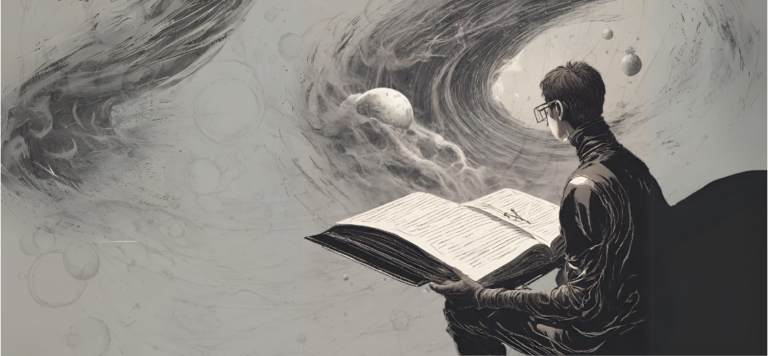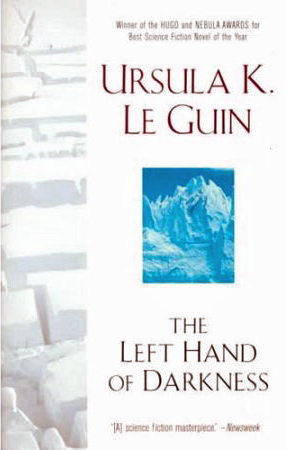Posted Blog Beats Beyond the Veil: An In-Depth Look at Arcane Magic in Fiction. Share on Facebook Tweet Subscribe Save

Dramatic Scene Cutaway:
The Ultimate Writers Tool
In this blog, I want to show you a monster technique for writers to add suspense and deepen reader immersion. The impactful dramatic cutaway is a powerful tool. The three varieties can enhance pacing, build suspense, and deepen immersion in a variety of mediums, and are a leviathan in an author’s writing arsenal. Let’s unravel the secrets behind this storytelling technique and uncover its transformative power in crafting unforgettable narratives.
There are three different ways of cutting away from a scene or not cutting away.
First, no cutaway. For example, Ursula K. Le Guin’s classic science fiction novel The Left Hand of Darkness has the main character Genly AI, and his companion, Estraven, attempting to cross the frozen Gobrin Ice together. Le Guin’s prose vividly captures the desolation and beauty of the frozen landscape, as well as the complex dynamics between Genly and Estraven as they rely on each other for survival. The scene is rendered with such immersive detail that readers are drawn into the characters’ experiences, feeling the bitter cold, the exhaustion, and the sense of urgency alongside them. After the scene concludes, the narrative continues seamlessly, depicting the aftermath of their journey and the consequences of their actions without any interruption or cutaway.
Second, is a cutaway to the aftermath, skipping all the action scenes. In the novel The Martian by Andy Wier, there are several instances where the narrative cuts away from astronaut Mark Watney’s struggle to survive on Mars to show the reactions of the people back on Earth. After Watney’s status as a stranded astronaut becomes public knowledge, the narrative frequently shifts to scenes of NASA personnel, politicians, and the general public reacting to the situation. These cutaways provide insight into the wider impact of Watney’s ordeal and the efforts to rescue him, adding depth to the story and highlighting the global stakes involved.
Thirdly, the falling cutaway where you leap past the aftermath, past the crisis, so there is a dying fall, and the action is not shown at all. Many authors use this to prepare the setup of the eventual starting place of the novel they want to write. For example, in The Fifth Season by N.K. Jemisin, after a massive earthquake, disrupts the stability of the continent, the narrative cuts away to a point in the future where society has been drastically altered by the disaster, with survivors struggling to adapt to the new reality. The scenes leap forward in the narrative in time, bypassing the immediate aftermath of cataclysmic events to show the world in a state of upheaval and transformation. This type of cutaway allows Jemisin to explore themes of resilience, adaptation, and the cyclical nature of history in her intricately crafted world. Other novels that use this are The Blade Itself by Joe Abercrombie, and The Final Empire by Brandon Sanderson. Or perhaps just picture Tina Turner in her role as Aunty Entity, ruler of Bartertown from Mad Max Beyond Thunderdome.
Now that we know the three types of cutaways, which ones have you seen in novels before? Let me give you a few more examples. As an author craft my style of storytelling, I’ve used the second way many times. It serves as a potent tools to maneuver between scenes. This technique is often found when the author abruptly switches focus from one scene or character to another, typically to heighten tension or reveal important information.
My novel Drayton’s Discoveries has multiple dramatic cutaways. Here is one part of the story where the Royal ships are traveling within a wormhole that is being built via the Interstellar Space Station located on Mars and traveling to Atax. As the action gets larger in space, I used a cutaway to focus on a few characters struggling within the underground habitation on the planet Atax. As that scene unfolds, once again the cutaway takes place to leap onto the enemy ship’s command deck in outer space.
While I couldn’t fit it all here as a sample, you can clearly see the first of these dramatic cutaways where I marked them.
“I want to fire on that small squad sitting in q3. Since they have decided to stick around, light them up as we exit, Nav. That should get someone’s attention,” Hooper’s deeper tone let the Nav know things just became more serious. The small dark-covered planet with its bright center grew steadily larger in the vid.
“Royal comm to Blueship Ma. Herald. Set fire solution for q3 squad party. You have permission to fire upon exiting the worm. I say again, you have permission to fire.” Nav quickly gave the command over the comm to the Alteric communications spacecraft.
“Arrival in -30 chrons, sir. Mark, mark, mark.” A corner of the vid became active displaying the exit time frame from the worm. With only thirty chrons to adjust, Hooper stared at the elements of his galactic chessboard and tilted his head. The smallest pawns waiting for his commands on his bridge gave him a glance or two but quickly attended to preparations for the game about to start.
The counter did its job, counting down. At minus 5 chrons the front scout ship slowed to allow the following ships to exit the rift. The fully extended wormhole transfer port sheared off and the blackness of the end enveloped everything within it. As if regurgitating its contents, the fleet of Martian-Alteric spacecraft flew out into the orbit of the terminus planet Atax.
Direct pulsar fire departed the Blueship Ma. Herald was an afterthought and destroyed the fighter squadron that was just turning to depart.
Captain Hooper hailed a comm to Atax on a general channel for anyone to hear.
“Atax Planet, this is Alteric Commandship Royal Flight 742, eminent arrival 20 chrons by hyperdrive. This is Commander Hooper. We are reporting hostel activity in orbit, we will be taking action effective immediately.”
The large group of Alteric and Martian ships spread out to cover the skies like a blanket. The smaller fighters 15 squadrons, and over 100 mobile shooters descended without stopping toward the Trabid ships.
The large group of Alteric and Martian ships spread out to cover the skies like a blanket. The smaller fighters 15 squadrons, and over 100 mobile shooters descended without stopping toward the Trabid ships.
*****Cutaway to focus in on the planet fight
Sam listened in the quietness of the tunnel. He heard only the shifting of rocks and pebbles still falling from the explosions that destroyed the exit. His torch beam cut through the clouds of dust and shale in the air by barely a meter. He was effectively blind as he moved slowly forward. He put his foot down on the unstable surface of a rock the size of his head and swept the light to get a firm step. As his light moved, it reflected off something shining. No, it was two somethings shining. Spirito’s eyes looked at him as he lifted the light once more.
“Spirito, it’s Sam.” Sam carefully made his way to the Canid’s position.
Spirito didn’t move but his breathing was visible and shallow. Sam set his pack down and reached into it to grab an oxygen mask. He slipped it over the Canid’s muzzle and pressed the small button. Oxygen was forced into Spirito’s airways. He seemed to revive from whatever meditative state and encouraged the mask, drawing in a deep breath of clean air and blinking.
Sam examined the position of the Canid’s large body, carefully pulling some rocks away and pushing some others. As he unburied the Canid, Spirito uncurled his form and hissed. His upper leg showed it was wrapped with bandages.
Here are a few more well-known examples.
The author R.R. Martin uses dramatic cutaways galore in his A Song of Ice and Fire series. In A Dance with Dragons when Jon Snow is making a critical decision at the Wall, and just as the tension peaks, the author abruptly shifts the focus to Daenerys Targaryen in Meereen, leaving readers eagerly anticipating the resolution of both storylines. My entire family groaned in agony. But quickly we were sucked into the Meereen saga with Daenerys.
I absolutely love how Suzanne Collins uses this cutaway technique in The Hunger Games as Katniss Everdeen navigates the treacherous arena. The author shifts focus between the action unfolding in the arena and the reactions of spectators watching the events unfold on television screens across the nation. <Three fingers salute>! These cutaways serve to underscore the psychological impact of the Games on both the participants and the wider society, heightening the stakes and emphasizing the brutal reality of the dystopian world depicted in the novel. By juxtaposing scenes of violence and survival the gripping narrative provokes deeper contemplation of the novel’s themes of power, oppression, and resilience.
In The Eye of the World, from Robert Jordan’s epic fantasy series The Wheel of Time, there’s a scene where Rand al’Thor, the protagonist, and his friends are being pursued by Trollocs (creatures of the Dark One) through the deserted city of Shadar Logoth. As the tension escalates and danger mounts, the narrative abruptly shifts to another group of characters, as Moiraine, Lan, and Perrin, face their own challenges elsewhere.
In Dune by Frank Herbert, one notable example occurs during a pivotal moment in the story when the young protagonist Paul Atreides, along with his mother Lady Jessica, are fleeing into the desert of the planet Arrakis after the fall of House Atreides. As they struggle to survive and evade their pursuers, Herbert abruptly shifts the narrative focus to other characters such as the treacherous Baron Vladimir Harkonnen and his scheming nephews Feyd-Rautha and Glossu Rabban, who are consolidating their power on Arrakis.
So, take a moment to think about your favorite novel find the cutaway, and see how that author did their magic to keep you reading. This technique heightens the tension and evokes powerful emotions within the audience. From the heart-pounding action sequences of a blockbuster film to the intricately woven narratives of a gripping novel, cutaways offer a cinematic flair that captivates readers and viewers alike.
Why do writers select one of the cutaways versus another to take the literary path they’ve chosen, using one of these cutaways?
The reasons are theirs but could include moving the pace, shooting for dramatic effects, skipping the aftermath, maintaining focus on a particular sequence or perspective, and showing the aftermath to provide closure to specific events or conflicts while exploring emotional fallout for the characters. These techniques can make the reader feel tension and intensity in the action. The reader can become immersed in the momentum. By understanding the different types of cutaways and how they are used in writing SFF novels, readers can gain a deeper appreciation for the intricate art of storytelling in these beloved genres.
In conclusion, cutaways are a powerful narrative technique used to shape the reader’s experience, evoke emotional responses, and drive the plot forward. Whether it’s showing the aftermath to provide closure and deepen characterization, leaping past the aftermath to maintain suspense and anticipation, or maintaining continuous focus to immerse readers in the immediacy of a scene, authors wield cutaways skillfully to control pacing, manipulate tension, and craft a compelling story.
Please read and review my serial publishing novel, Sparrow’s Legacy, on Kindle Vella. You can read the first three chapters free on Amazon by searching for “Sparrow’s Legacy Kindle Vella” or clicking here. Or you can find my debut SFF novel, the space opera Drayton’s Discoveries. For the love of all fantasy and SFF, please leave a review. Feedback is my sole sustenance for writing. Don’t let me starve. If you liked this blog, please be sure to sign up for future blogs on my site jlnichauthor.com
For those trying the writing game, I want to give a quick shout-out to PLOTTR software. I’ve found it has really improved my writing game and increased my efficiency tremendously. It is my new favorite writing aid. Use any of my affiliate links below and I might get a small commission. Thanks.
Check out my YouTube channel for PLOTTR videos @jlnichauthorsff
Joseph Michael’s Learn Scrivener Fast e-course
Please read and review my serial publishing novel, Sparrow’s Legacy, on Kindle Vella. You can read the first three chapters free on Amazon by searching for “Sparrows Legacy Kindle Vella” or clicking here. I. Please subscribe to my website if you want to be notified when I’ll be publishing or to get free samples of my work.
JL Nich, Science Fiction Fantasy Author


